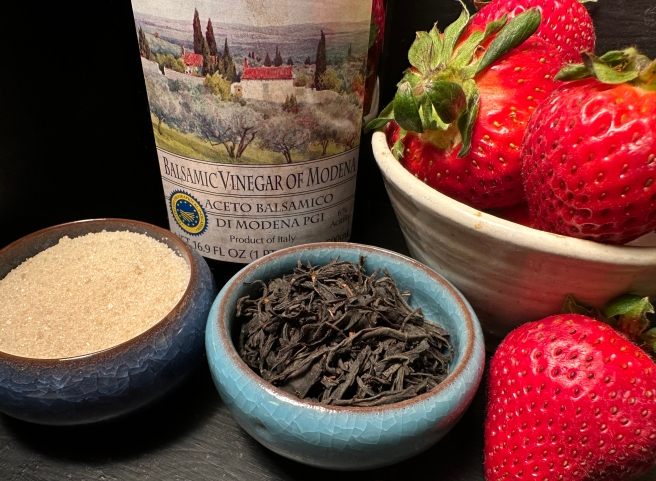The annual World Tea Expo fosters exploration, innovation, networking. Tea industry producers, importers and distributors, tea shop owners, restauranteurs, and tea drinkers sample and discuss teas, teach or attend classes, peruse tea-related merchandise, and network.
Why should you care? Well, products that catch the eye of attendees may possibly turn up in your local tea shop, restaurant, or even big-box store at some point!

This year, in an arguably more novel and fun vein, Lisa of TeaHaus, Ann Arbor, and Phil (Mammoth Distilling) taught popular classes that demonstrated how to use tea leaves as a spice, a dry ingredient, an infusion, a cocktail component. (Who doesn’t like a class with food and drink samples?!) Their goal is to spread the word that tea leaves are incredibly versatile.
And this isn’t just adding a cup of brewed earl grey tea to a cocktail.
No, it’s using tea at the foundation, using tea to layer flavors and create complexity. It’s turning upside down our notions of what tea is and revealing limitless culinary and mixology possibilities.
My last post introduced the deep connection between tea and alcohol, and I touched on Lisa’s and Phil’s use of tea in shrubs, syrups, and infusions in spirits. Let’s dive in a little deeper.
Tea Shrubs
Shrubs—or drinking vinegar—are ideal for preserving seasonal fruit. At the concentrations used in a shrub, both the sugar and the vinegar will ensure the shrub is safe to consume for a very long time. In fact, I’ve been told that shrubs can keep for two years (though I can’t imagine waiting that long to drink something so delicious), but drink them within two weeks if you want to follow FDA recommendations.
Lisa provides a couple shrub recipes on the TeaHaus website to get you started, and I walked through some of the thought process of making a shrub in an earlier post (which also gives a brief history of the shrub).

Just open your mind to the endless types, combinations, and ratios of fruit, vinegar, and tea! Although you don’t need to add anything else to a fruit and vinegar shrub, consider these possibilities, suggested by Lisa:
- Add soda water (3–6 oz to 2 oz shrub)
- Add spirit (1.5–2 oz to 0.75–1.5 oz shrub)
- Add a shot of flavored spirit, such as Mammoth Distilling strawberry rhubarb vodka
And shrubs aren’t just for drinking. Lisa has these tips as well:
- Reduce the shrub to use for a salad dressing
- After you strain out the fruit, purée it and use in sauces or as a salad dressing
Tea Syrups
Tea syrups are another way to use tea leaves in a fun way. Most of us know how to make a simple syrup. Just heat equal parts sugar and water and that’s it. But what if you use tea rather than water? Think of all the flavors you can create!
To make sure you have sufficient flavor, brew the tea about twice as strong as you normally would. When it’s done brewing, pour the hot tea over an equal volume of sugar, stirring to dissolve the sugar. And as with shrubs, the type of sugar you use will also impact the syrup’s flavor.

Many fruit teas (no tea leaves) make incredible syrups that are delicious added to sparkling water. These are healthy, no-caffeine, nearly calorie-free, and super delicious substitutes for soda. For the grownup version, add to sparkling wine (prosecco is nice).
But you can also use tea leaves to make syrups, and some choices are ideal for savory dishes.
Try Assam black tea and brown sugar to make a syrup and use in an Old Fashioned (see Tea for Dummies). Or, instead, for a smoky note in that same cocktail, use Lisa’s lapsang souchong syrup (see TeaHaus website).
As Lisa noted in her class, she uses this smoky lapsang syrup in pastries or generously drizzled over warm goat cheese served with crackers.
A Note about Lapsang Souchong Tea
Genuine lapsang souchong is an incredibly smoky tea because the leaves have absorbed pine wood smoke. I personally dislike it as tea by itself but I find it extremely versatile in other beverages and in cooking. Think of all the things you make that work well with a touch of smoke: stews, chili, hamburgers, grilled meat or veggies, and so on. Rather than use a smoke flavoring, use lapsang leaves as a dry rub, crumbled with your fingers or run through a grinder and tossed into the cooking pot, or brewed and substituted for some of the cooking liquid.
Lisa makes a lapsang culinary spice blend that elevates party mix. It can be used in any type of cooking where you want some smoky spiciness. I keep both lapsang tea leaves and Lisa’s lapsang spice blend with my cooking spices.

I’ll take a closer look at tea infusions with spirits next. Meantime, for more recipes from both Lisa and Phil, see our book Tea for Dummies, available at your favorite bookseller or at TeaHaus.
In addition, see my post from the 2021 Expo, which goes into more detail in how to incorporate tea in your cooking and baking.
